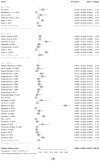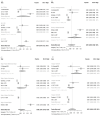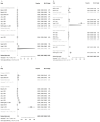A Meta-Analysis of the Prevalence of Wheat Allergy Worldwide
- PMID: 37049405
- PMCID: PMC10097276
- DOI: 10.3390/nu15071564
A Meta-Analysis of the Prevalence of Wheat Allergy Worldwide
Abstract
Wheat allergy is a primary disease of food allergy, and its global prevalence is unclear. This study aimed to characterize the latest worldwide prevalence of wheat allergy based on five different diagnostic methods. Study searches were conducted in Web of Science, PubMed, Ovid LWW, and Cochrane database, with a time limit of 1 January 2007 to 1 September 2022. The review and screening of the articles was undertaken by two independent reviewers. The statistical analysis was conducted by R. A total of 56 articles were finally included. The prevalence of wheat allergy was 0.63% (95% CI: 0.43-0.87%) for self-reported, 0.70% (95% CI: 0.18-1.22%) for self-reported physician-diagnosed, 0.22% (95%CI: 0.07-0.65%) for skin prick test positive, 0.97% (95% CI: 0.43-2.20%) for specific immunoglobulin E positive, and 0.04% (95% CI: 0-0.16%) for food challenge. However, food challenge can be largely subjective, and the results were only based two countries, so the prevalence of wheat allergy confirmed by food challenge may be not entirely trustworthy. In conclusion, investigating the prevalence of wheat allergy in the real world as accurately as possible will contribute to the prevention, management, and risk assessment of wheat allergy.
Keywords: meta-analysis; prevalence; wheat allergy; worldwide.
Conflict of interest statement
The authors declare that the research was conducted in the absence of any commercial or financial relationships that could be construed as potential conflict of interest.
Figures









Similar articles
-
Prevalence and Clinical Symptoms of Wheat Allergy in Adults and Adolescents in Central Europe.Clin Exp Allergy. 2025 Apr;55(4):319-329. doi: 10.1111/cea.70017. Epub 2025 Feb 19. Clin Exp Allergy. 2025. PMID: 39973050 Free PMC article.
-
Assessment of Allergy to Milk, Egg, Cod, and Wheat in Swedish Schoolchildren: A Population Based Cohort Study.PLoS One. 2015 Jul 2;10(7):e0131804. doi: 10.1371/journal.pone.0131804. eCollection 2015. PLoS One. 2015. PMID: 26134827 Free PMC article.
-
Positivity rates of in vitro inhalant/respiratory and food allergy tests in the northern midwestern United States.Ear Nose Throat J. 2018 Sep;97(9):296-322. doi: 10.1177/014556131809700919. Ear Nose Throat J. 2018. PMID: 30273429
-
Current trends and investigative developments in wheat allergy.Int Rev Immunol. 2015;34(6):538-41. doi: 10.3109/08830185.2015.1065827. Epub 2015 Aug 4. Int Rev Immunol. 2015. PMID: 26288112 Review.
-
Clinical presentation, allergens, and management of wheat allergy.Expert Rev Clin Immunol. 2016;12(5):563-72. doi: 10.1586/1744666X.2016.1145548. Epub 2016 Feb 11. Expert Rev Clin Immunol. 2016. PMID: 26800201 Review.
Cited by
-
Prevalence and Clinical Symptoms of Wheat Allergy in Adults and Adolescents in Central Europe.Clin Exp Allergy. 2025 Apr;55(4):319-329. doi: 10.1111/cea.70017. Epub 2025 Feb 19. Clin Exp Allergy. 2025. PMID: 39973050 Free PMC article.
-
Positive rate of wheat allergens in the Chinese allergic population: a systematic review and meta-analysis.Sci Rep. 2023 Jun 29;13(1):10579. doi: 10.1038/s41598-023-37648-2. Sci Rep. 2023. PMID: 37386279 Free PMC article.
-
Allergens from wheat and wheat products: A comprehensive review on allergy mechanisms and modifications.Food Chem X. 2025 Aug 5;29:102871. doi: 10.1016/j.fochx.2025.102871. eCollection 2025 Jul. Food Chem X. 2025. PMID: 40823125 Free PMC article. Review.
-
Glutenin from the Ancient Wheat Progenitor Is Intrinsically Allergenic as It Can Clinically Sensitize Mice for Systemic Anaphylaxis by Activating Th2 Immune Pathway.Int J Mol Sci. 2024 Jul 3;25(13):7324. doi: 10.3390/ijms25137324. Int J Mol Sci. 2024. PMID: 39000431 Free PMC article.
-
Evaluation of Sourdough Bread and Its Potential Use in Support of the Treatment of Chronic Non-Communicable Diseases.Nutrients. 2024 Jul 31;16(15):2485. doi: 10.3390/nu16152485. Nutrients. 2024. PMID: 39125365 Free PMC article.
References
-
- Piboonpocanun S., Thongngarm T., Wongsa C., Pacharn P., Reamtong O., Sompornrattanaphan M. Omega-5 and Gamma Gliadin are the Major Allergens in Adult-Onset IgE-Mediated Wheat Allergy: Results from Thai Cohort with Oral Food Challenge. J. Asthma Allergy. 2021;14:907–917. doi: 10.2147/JAA.S315202. - DOI - PMC - PubMed
Publication types
MeSH terms
Substances
Grants and funding
LinkOut - more resources
Full Text Sources
Medical

